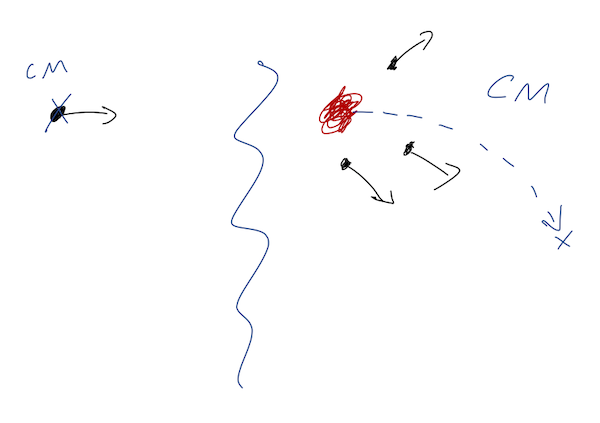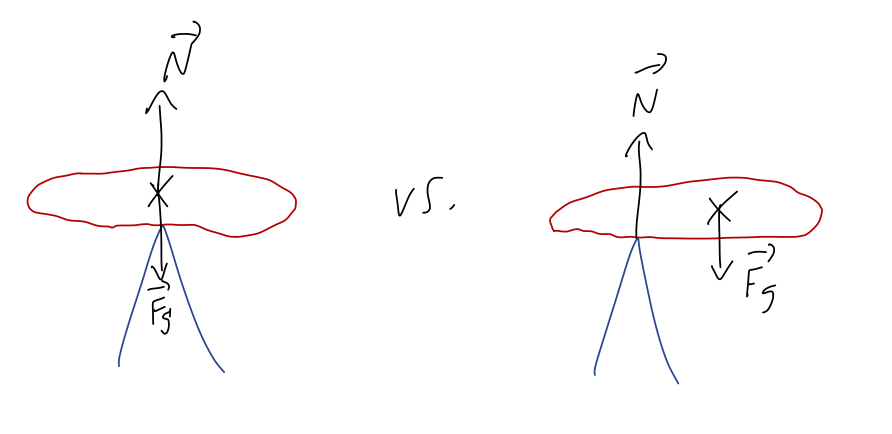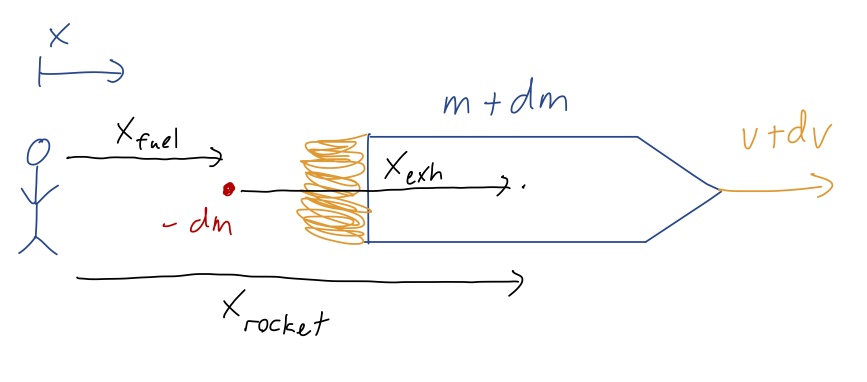Now that we have a good idea of how to find the CM, we should step back for a moment and reflect on why it's useful to find the CM. Formally, the CM is a useful idea because if we only have external forces pushing a large object around, we can treat the whole thing as a point particle located at the CM. There are a few more specific implications of this fact:
Explosion and collision problems: Since the CM position obey's Newton's second law with respect to external forces,
\[ \begin{aligned} \vec{F}_{\rm ext} = m \ddot{\vec{R}}, \end{aligned} \]
we know that for processes with just internal forces, like an explosion, the CM will move as if no forces at all are acting upon it! (More realistically, we usually have at least gravity. For an object exploding in mid-air, for example, the CM of the pieces will continue to move as a simple free-falling point mass, even after the explosion!) Using the CM can give a more economical way to deal with such momentum-conservation problems.

Balancing forces: One of the more well-known properties of the CM is that an object can be balanced even on a point, so long that CM is directly above the balance point. We can sketch the gravity and normal forces as follows:

Gravity always acts straight down on the CM, but the normal force direction is always perpendicular to the contact between the sufraces. So if our object is tipped over slightly, the normal force will no longer balance against gravity completely, and the net force will cause the object to tip further.
You might ask: what if I had a completely flat object balanced on a thin rod? Once again, our flat object will tip over unless the rod is placed directly below the CM. But in this case, it seems like the normal force is always straight up, so why is the motion different?

The answer is that there are two ways an extended object can move: in addition to the CM itself moving around in space, an extended object can rotate. As you'll recall from intro physics, rotation is caused by torque, \( \vec{\Gamma} = \vec{r} \times \vec{F} \). Because gravity is proportional to mass, \( \vec{F}_g \) always acts on the center of mass, but the normal force acts at the point of contact - giving a net torque and causing rotation, unless the normal force is also applied at the center of mass, in which case \( \vec{r} = 0 \) in the torque equation.
We'll consider rotation and torque, and the associated conservation law for angular momentum, at the end of this section. (Detailed study of rotation can get pretty complicated, and will mostly be left to next semester.) But first, I want to use our improved understanding of momentum conservation to tackle one more new type of problem, which is rocket propulsion.
Rockets
The basic idea of rocket propulsion follows directly from what we've seen about conservation of momentum. For a compound system, as we've seen, we can change the momentum of one part of the system by causing some motion to happen to another part. In our boat example problem, the person can actually move the entire boat just by walking across it in the opposite direction. However, there are practical limits in that case: the person can only walk so far, and as we saw the distance from person to dock always increases in that example - so you can't use this trick to make it back to dry land if your motor shuts off.
A better way to exploit conservation of momentum in the boat example is by using projectiles. If you take an object on the boat and throw it overboard, conservation of momentum requires that the boat will be pushed forward in the opposite direction. Since the object is separated from the boat, we can get closer to dry land in this way - the only practical limit is how many things we have to throw in order to propel ourselves forwards.

This is, in fact, an example of rocket propulsion: the idea of propelling a vessel forwards by ejecting part of its mass in the opposite direction that we want to travel. If we consider the vessel and the ejected mass to be part of the same system, there are only internal forces active, so we have \( d\vec{P}/dt = 0 \). Of course, throwing things by hand isn't very efficient; when I say the word "rocket", you probably picture something that uses a chemical reaction to eject super-hot gas.

Keeping the latter example in mind, we'll assume our rocket is continuously ejecting mass at a rate \( dm/dt \), so the rocket itself has a mass-dependent time \( m(t) \). The speed at which the mass is ejected, called the exhaust speed \( v_{\rm exh} \), is also important. To begin with, we'll assume all external forces are zero; it will be easy to generalize.
Now, you might be tempted to just write down Newton's second law \( d\vec{P}/dt = 0 \), and then say that since \( \vec{P} = m\vec{v} \), you can expand out the derivative to get something that looks like a rocket equation. However, the resulting equation is wrong! The reason is that the \( m \) above is really \( M \), the total mass of the system, which is not changing with time because it includes the ejected mass. If we try to exclude the ejected mass, then we no longer have a closed system with only internal forces, and we can't use these equations at all.
Let's work more carefully. What does an observer on the ground see, watching the rocket system? Let's set up some coordinates, considering both the rocket and an infinitesmal bit of mass \( dm \) being ejected, and just considering motion in a single direction \( x \):

The "after" case closely resembles our boat example - it was more practical than it looked! In particular, we already know that we can write a relationship between the speeds,
\[ \begin{aligned} v_{\rm fuel} = -|v_{\rm exh}| + (v + dv) \end{aligned} \]
which will be very useful. (I'll treat \( v_{\rm exh} \) as a speed which is always positive, the absolute value sign is just to reinforce this fact.) Notice also that the mass of the fuel is \( -dm \), i.e. \( dm \) itself is negative - this is so that \( dm/dt < 0 \) for the rocket itself, which it has to be since it's losing mass.
By the way, we can check a couple of other limits to make sure that we have everything right here. Ignoring the tiny change \( dv \), if \( v=0 \), we see that \( v_{\rm fuel} = -|v_{\rm exh}| \) - if the rocket and the observer are both at rest with respect to each other, then from either perspective it looks like the fuel is coming out at the exhaust speed, to the left. If instead \( v = +|v_{\rm exh}| \), then \( v_{\rm fuel} = 0 \). If the rocket is moving right at exactly the exhaust speed, then the fuel looks like it's at rest when ejected, according to the ground observer. (Convince yourself that this makes sense!)
Now we apply conservation of momentum:
\[ \begin{aligned} \vec{P}(t) = \vec{P}(t+dt) \\ mv = p_{\rm fuel} + p_{\rm rocket} \\ = (-dm) v_{\rm fuel} + (m+dm) (v + dv) \end{aligned} \]
Cancelling off the \( mv \) on both sides, this becomes
\[ \begin{aligned} 0 = (-dm) (-|v_{\rm exh}| + v + dv) + v dm + m dv \\ -|v_{\rm exh}| dm = m dv \end{aligned} \]
where a couple more cancellations have happened. Finally, we apply a time derivative:
\[ \begin{aligned} m \frac{dv}{dt} = -|v_{\rm exh}| \frac{dm}{dt}. \end{aligned} \]
This is the rocket equation, which will let us calculate the motion of the rocket. Remember, the rocket is losing mass, so \( dm/dt < 0 \), which means that \( dv/dt > 0 \), i.e. the rocket moves forwards. Since this ends up looking exactly like Newton's second law, we can identify the right-hand side as a force, called the thrust:
\[ \begin{aligned} \vec{F}_{\rm thrust} = -|v_{\rm exh}| \frac{dm}{dt} \end{aligned} \]
For a rocket to achieve larger thrust, we see that either the reaction has to be faster (so \( |dm/dt| \) goes up), or more energetic (so \( |v_{\rm exh}| \) goes up.)
In general, we could have a rocket where the exhaust speed is a function of time. However, if it is constant, we can easily integrate to find the motion. It's slightly more general to do this by cancelling the \( dt \)'s off again, rewriting the rocket equation as
\[ \begin{aligned} -\frac{dv}{|v_{\rm exh}|} = \frac{dm}{m} \\ v(m) = -|v_{\rm exh}| \ln m + C \end{aligned} \]
Using the generic initial condition that \( v(m_0) = v_0 \), we have
\[ \begin{aligned} C = v_0 + |v_{\rm exh}| \ln m_0 \\ \Rightarrow v(m) = v_0 + |v_{\rm exh}| \ln (m_0/m). \end{aligned} \]
Since this relates \( v \) to \( m \) directly, this is true whether or not \( dm/dt \) is constant. (If \( dm/dt \) is constant, then we have constant thrust and we can just find \( m(t) \) and then integrate with respect to time.)
The bad news in this equation is that we have a logarithmic dependence on mass - this makes it very difficult to increase the top speed of our rocket by just adding more fuel! To be concrete, we can write
\[ \begin{aligned} m_0 = m_E + m_F \end{aligned} \]
where \( m_E \) is the mass of the empty rocket, and \( m_F \) is the mass of the fuel. (If you're looking up real-world information on rockets, \( m_E \) is often called the "dry mass", while the total \( m_E + m_F \) including the fuel is the "wet mass".) Then the top speed of the rocket, if it starts from rest, is
\[ \begin{aligned} v_{\rm max} = v(m_E) = |v_{\rm exh}| \ln \left( 1 + \frac{m_F}{m_E} \right) \end{aligned} \]
So if the exhaust velocity is fixed, just making our rocket bigger alone won't help; if we double the size of the rocket and both \( m_E \) and \( m_F \) are twice as large, the top speed doesn't increase at all! We need to either increase \( m_F \) without making the rocket heavier, or make \( m_E \) lighter with the same amount of fuel.
Even if we can accomplish those engineering feats, the gains are heavily diminishing. Suppose we build a rocket which has 90% of its mass devoted to fuel, so \(m_F = 10 m_E\). Then its top speed is about 2.4 times \(|v_{\rm exh}|\). If we somehow strip nearly all the mass out of the rocket and make a better design which is 99% fuel by mass, then \(m_F = 100 m_E\), but the top speed will only go up to 4.6 times \(|v_{\rm exh}|\). Physically, it's easy to see the problem: to get more total thrust we need more mass to eject, but if we start with more mass, then we get less speed for the same amount of thrust.